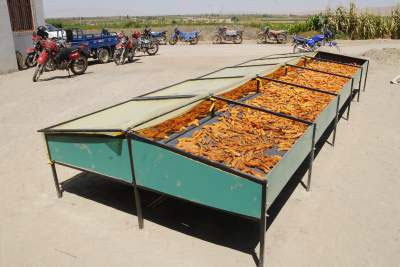FOR weeks, NAREI in Focus has provided readers with information on solar drying. By now readers are familiar with what solar drying is, the different types of solar dryers and the importance of not over drying fruits and vegetables. This week readers will be exposed to the process for dried fruit production.
PREPARATION OF THE FRUIT
All fruit to be dried should be hand-picked and not shaken from the tree. To obtain optimal yields of top quality dried product, all fruit should be ripe and free from bruising. Any rotten or bruised fruit should be thrown away. For maximum profitability, the dryer should be loaded to full capacity as often as possible. It is advisable to acquire more fruit than required.
 Bananas have a low level of acidity and turn brown very rapidly after peeling and cutting. To prevent this, they should be immersed in water containing sodium metabisulphite (400 parts per million of sulphur dioxide) immediately after peeling.
Bananas have a low level of acidity and turn brown very rapidly after peeling and cutting. To prevent this, they should be immersed in water containing sodium metabisulphite (400 parts per million of sulphur dioxide) immediately after peeling.
Unpeeled fruits should be washed in a mild disinfectant solution made from one part of bleach to 50 parts of water. Care must be taken not to break the skin of the fruits as this will contaminate the flesh.
Gloves and aprons must be worn to protect the workers’ hands and clothes. Ten litres of treated water will be sufficient for about 20kg fruit. The wash water should be changed after this amount has been washed as it becomes contaminated by the fruit.
Soft fruit, such as berries and apricots, are delicate and should be handled carefully to avoid bruising.
Washed fruits are carefully peeled to remove all the peel and any damaged parts of the flesh. Fruits are cut into slices of varying thickness depending on the type of fruit and the dryer. The following points are useful to consider: thick pieces dry at a slower rate than thinner ones; very thin pieces tend to stick to the drying trays and may be difficult to remove; thicker pieces may not dry fully in the centre and will not store well; packets of mixed thick and thin pieces do not look attractive.
BLANCHING OR SUGARING
This stage is optional, but some processors choose to soak fruits in sugar syrup prior to drying. There are several benefits in this process. There are also constraints to sugaring. Fruit pieces are immersed in a concentrated sugar solution for up to 18 hours. They are rinsed in clean water to remove any excess syrup before drying.
Most vegetables and some fruits are blanched before drying to inhibit enzyme activity and to help preserve the colour. The material is cut into appropriately sized pieces and plunged into boiling water for up to five minutes. They should be blanched in small batches to ensure that each piece is properly heated through.
If too many pieces are put into the water at one time, the water temperature will drop and prolong the blanching time. After blanching for the required time, vegetables are rapidly cooled by plunging into cold (or iced) water.
SULPHURING
Sulphuring or sulphiting is an optional stage of processing. The main benefit of sulphuring is to preserve the colour of the fruit. Some consumers object to chemical preservatives and prefer naturally dried fruits. Sulphur dioxide gas (SO2) is applied to the fruit pieces by placing them in a cabinet or tent in which sulphur is burned.
The gas is absorbed by the fruit. For most fruits, 5-6g sulphur per kg food is adequate. The gas given off is toxic and corrosive. Therefore, sulphuring should be carried out in a well-ventilated place, using appropriate equipment. See the information on sulphuring for more details. Sulphite can be included in the sugar syrup (as sodium or potassium metabisulphite).
DRYING
Fruit pieces are arranged on mesh-bottom trays so that they are not touching or overlapping. The fruit should be loaded into the trays as soon as it is cut. This prevents the pieces from sticking together and allows the drying process to start as soon as possible.
The trays should be brushed clean to remove any old fruit pieces. They should be loaded into the dryer as soon as they are ready. The dryer doors should be closed after each tray is loaded. Direct sunlight should be avoided as this bleaches the colour and reduces the level of vitamins A and C.
The drying temperature should be controlled to avoid over-heating and spoilage of the fruit. Most fruits are dried at about 60-70 degrees C. Fruits are dried until they have the desired final moisture content (15 percent for conventionally dried fruits; 20-25 percent for osmotically dried (sugar-treated fruits).
PACKAGING
Dried fruits should be packaged immediately after drying to prevent them absorbing moisture from the surrounding air. After drying, fruits can be packed in bulk in sealed moisture-proof polyethylene bags then packed into smaller packets at a later date.



.jpg)








